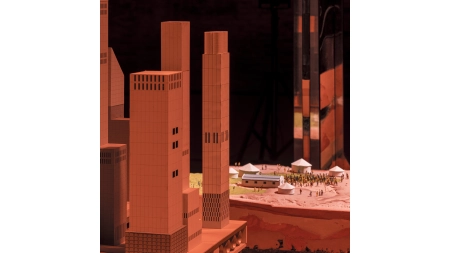
Andrés Jaque
When smoke from wildfires in Canada turned the New York City air orange last week, architect Andrés Jaque noted an eerie parallel between the smoky sky and an installation that he premiered at the latest Venice Design Biennale. Titled XHOLOBENI YARDS. Titanium and the Planetary Making of SHININESS / DUSTINESS, the piece shows a cityscape immersed in an apocalyptic orange glow. But the parallel that Jaque noticed went beyond this visual echo, piercing the very heart of the project’s theme—that though design can help mask the reality of climate change, its effects cannot be escaped.
The idea for XHOLOBENI YARDS was put into motion when Jaque was walking through Hudson Yards, a commercial hub in New York City crowned with a structure dubbed The Vessel, a large, honeycomb-like assembly that offers nothing but stairs and views, and is closed indefinitely following a series of suicides there. But what Jaque noticed was how shiny it was: blindingly, impossibly shiny.
Jaque discovered that the vessel’s shininess is made possible by a titanium-derived coating that not only provides a reflective layer but, incredibly, draws pollutants from the air through a process called photocatalysis; it converts harmful pollutants into harmless soluble nitrate salts that get washed from a building’s facade with rainfall. When Jaque traced how such a titanium material is derived however, he found pollution on the other end. The titanium is extracted from sand in Xolobeni, South Africa; stripped of the heavy metal, the sand becomes volatile and light, effectively transforming it into dust.
Jaque put it in simpler terms: “For Hudson Yards to be that shiny, Xolobeni needs to be dusty.”
The extraction process has transformed Xolobeni, as the ground itself lifts with the breeze and covers houses and crops, wends its way into people’s lungs, and weakens local economies. Demand for this metal has created the potential for a titanium mine in Xolobeni, led by the Australian company Mineral Commodities Ltd. The mine would destroy the landscape on which the Xolobeni people subsist. Resistance to the project has led to an uptick in violence against activists, leading a major investor to divest from the mine, though Mineral Commodities still holds a major stake and is attempting to find a way through.

Jaque is particularly interested in how well-to-do cities that house the global elite attempt to isolate themselves from pollution and climate change using design that shifts the environmental crisis onto others.
“Post 2008, people figured out that buildings store money by creating spaces where climate crisis and environmental toxicity could be excluded and sent elsewhere so the elite could escape the consequences of this crisis,” Jaque said. “What we’re seeing is this impossible project of ‘securing’ global locations like New York, London, and Hong Kong as locations where environmental damage can be removed.”
One example of how this has played out in New York is then Mayor Michael Bloomberg’s PlaNYC initiative from the early 2010s. The program’s Clean Heat component was designed to improve New York City air quality by swapping out the heavy oils used to heat buildings with natural gas. The plan was enormously effective in the city, with levels of sulfur dioxide dropping by 69 percent, and the level of soot pollution dropping by 23 percent.
However, as a piece for Tablet Mag revealed, an increased demand for “cleaner” natural gas meant an increased demand for fracking, a notoriously dirty extractive process that Bloomberg himself resisted when plans to frack in New York State came up. So the fracking that fueled New York was done in Pennsylvania, with a pipeline connecting Pennsylvania to New York’s Meatpacking District built under Bloomberg’s administration.
“Looking at the exceptional quality in a city like New York, a place where so much pollution is produced, creates the false impression that it is possible to get rid of waste when it’s really just relocated,” said Jaque. “Relocated, that is, to places where the population is often racialized and has less financial resources.”
XHOLOBENI YARDS visualizes a world in which New York is surrounded by the effects of pollution that it itself engenders in other places, whether it be nearby Pennsylvania or far-flung South Africa. And then the hypothetical became reality: smog descended on a city designed to feel safe from the kinds of chaos that fossil fuel investment manifests.
“Events like this make it possible to see [climate change], to smell it, to feel it in our lands, to feel it in its whole violence that a big part of the world is already feeling,” said Jaque. “The climate crisis is not something that will happen in the future. It’s already happening. It’s only the accumulation of power in places like New York that allows it to not be sensed.”

Jay Tyson Reist
‘They’re Trying to Erase Us’: Chevron Takes Down Public Art Piece
Munich Court Hears Arguments, Climate Activists on Trial for Damaging Frame in Germany

RobbReport
Pocket Watches From Patek Philippe, Zenith, and More Star in a New N.Y.C. Exhibition

WWD
Waxon, Sous La Face Prep Launch of Co-branded Beauty Destinations

BGR
Netflix might kill its cheapest Basic plan, and I don’t know why it exists to begin with

Sportico
ESPN Extends Reality in New Studio Built With ‘Mandalorian’ Tech

SPY

